| The
Great Basswood Adventure |
Edward
Frank |
| May
25, 2007 07:27 PDT |
ENTS,
May 15, 2007
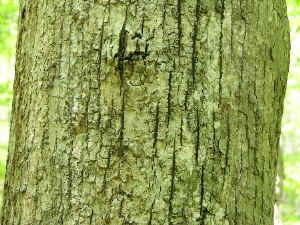
Basswood Bark - photo by Ed Frank |

Basswood Leaves - photo by Ed Frank |
Basswood (Tilia Americana). Most people can not identify
basswood. It
is an unremarkable tree known more for the fact that its wood is
soft
and easily carved than for any other reason. My mission today
was to
collect a cross-section slab or a “cookie” from a downed
basswood tree
that had fallen across the Slippery Rock Gorge Trail in
McConnell’s Mil
State Park in western Pennsylvania. Three of us were on the
trip,
myself, Carl Harting, and Anthony Kelly. All are members of the
Eastern
Native Tree Society (ENTS). The tree had fallen around five
years ago
and park employees had used chain saws on the log to clear the
path for
the trail. Last summer on a measuring trip to the area we paused
and
counted the rings on the exposed chain-sawed end of the tree, At
19.2
feet above the base of the tree we counted 178 rings. All the
rings
were close together, growing with even finer bands near the
outer bark.
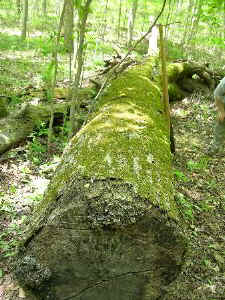
Downed basswood log - photo by Ed Frank |
The question we ask ourselves was how long can basswood live?
Nobody
really knows. It is generally thought of as a short lived tree
reaching
maybe 100 to 150 years old. Here was a specimen that was much
older
than that. A search of the International Tree Ring Database
found no
listings for American Basswood, nor were there any listings in
the
OLDLIST or the Eastern OLDLIST tree ring databases for the
species. Dr.
Neil Pederson, a dendrochronologist from Eastern Kentucky
University
emailed me some additional information: “My class did core a
basswood
this fall that was solid, believe it or not. I recall the age
was in the
180 yr range. It has not been crossdated, so will not be listed
anywhere
any time soon. I hope to go back with another class next fall.
Perhaps
we can pick up a new age then. But, no, I haven't found any
[published]
ages.” The more I thought about it the more
interested I became in
this particular dead tree. I applied for a permit from the PA
DCNR to
collect a section and received approval. After a number of
delays,
today we were finally going to get the specimen.
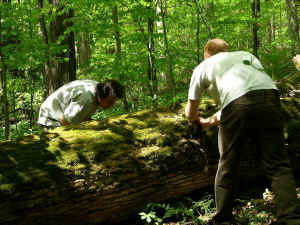
photo by Ed Frank |
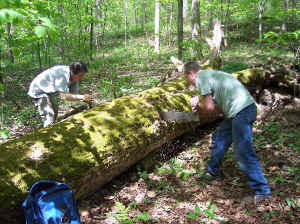
photo by Carl Harting |
Carl, Anthony, and I met at the main parking lot at
McConnell’s Mill mid
morning, consolidated vehicles, and drove over to the jumping
off point
for the hike. The hike started a half mile or so back from back
from
the edge of the Slippery Rock Creek gorge. I borrowed a long
crosscut
saw and a peavey for the trip, so we loaded up and hiked to the
bottom
of the gorge. It was a bright sunny day. The leaves were out on
the
trees, but still retained some of the spring colors. Mayapple
flowers
and violets lined the path through the forest. Anthony, Carl,
and a few
others have been working at documenting the giant trees in the
park for
several years. Five species found in the park are either the
tallest of
their species known in Pennsylvania or in the entire
northeastern United
States. An American basswood in the immediate vicinity of the
downed
tree, at 127.1 feet tall, is the tallest accurately measured
specimen in
Pennsylvania and is within a half foot, effectively tied for the
tallest
measured for the species.
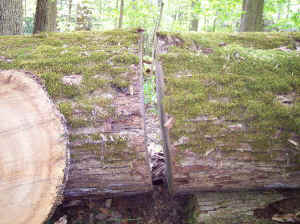
photo by Carl Harting |
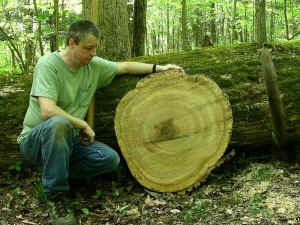
The cookie was between 28.5 and 31.5 inches in
diameter without the bark. The bark would add
another 1.5 inches to the diameter - photo by Ed Frank |
The fallen tree looked bigger than I remembered when faced with
the
prospect of cutting and removing a cross-section. After five
years there
was some decay on the tree and its upper surface was covered by
lichens
and moss. The bottom of the gorge was distant from the outside
world.
The water rushed in the creek a few feet away, the wind blew
through the
trees, birds were singing, and a cardinal was flitting among the
bushes
on the edge of the creek. The original plan was to remove a
short
section from the exposed end of the tree where it had been cut
to clear
the trail. However, the end of the tree was beginning to decay,
so I
opted to cut a section from the intact trunk seven feet above
the base
of the tree. Carl, Anthony, and I took turns pairing up on the
cross-cut saw and fairly quickly we had cut a 2 inch thick
“cookie” from
the soft wood. The sawdust smelled sweet in the warm spring air.
The
slab was beautiful. The center point of the tree rings was
slightly
off-center from the edges. Different ring widths could be seen
throughout the life of the tree. Wider rings marked periods of
quick
growth, likely when the area was more open, and finer rings
marked
periods of slower growth. Anthony did a quick field count of the
rings
and conservatively counted 187 rings. That means this tree first
sprouted around 1815.
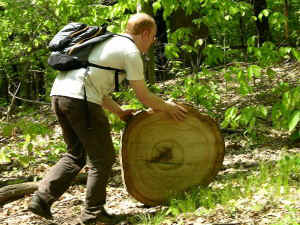
photo by Ed Frank |
Now the big problem – getting the cross-section back to my
van. I had
stupidly not thought to bring a dolly or anything else to help
carry the
slab. Taking turns we briefly carried and mostly rolled the
specimen up
out of the gorge and back to the van. This was a strenuous
process and
I must salute my fellows on their superhuman efforts. I am sure
they
moved the cookie far greater distances than I. As we made our
way back
to the vehicles the estimate of the weight of the cross-section
went up.
Later I found the weight to be 71 pounds. Eventually we reached
the
vehicles, loaded the cross-section, went our separate ways, and
I
headed home. The section was not any worse for the wear of the
long
roll up out of the gorge. The plans at this point are for me to
sand the
cross-section with progressively finer grit sandpaper. This will
enable
a more a more accurate ring count and I will able to obtain a
truer age
for the specimen. After this preliminary processing the sample
will be
sent to Dr. Pederson for further examination.
Of the three hundred fifty species of trees found in the eastern
United
States, perhaps four dozen have had any cross dating. Most
people doing
tree ring research, and there are only a few in the United
States, are
interested in determining the history of a particular site, so
obviously
they select the trees with the longest life spans. Generally
seven or
more core samples are required from an area to do cross dating.
This
process involves comparing the differences in ring widths among
the
specimens to determine if there are rings missing, or if there
are extra
rings present in individual samples. Then a composite corrected
tree
ring sequence is compiled from the samples. It is much more
accurate
than simple ring counts of specimens. The shorter lived trees,
like
basswood, are only sampled occasionally and the results are
rarely
published as there are seldom enough samples collected to do
cross
dating. Even for the species for which there
are cross dated tree ring
sequences, these sequences in many cases do not include the
oldest
specimens for a species, or provide information on the maximum
ages that
a species can reach. Given the general lack of information on
the
maximum ages various tree species can reach, efforts like this
collection of a single sample of an individual old tree can help
fill in
the gaps in our knowledge of this species and of the area in
which it
was found.
I will be taking the sample to Dr. Pederson in mid-June when I
attend
the First Kentucky Old-Growth Conference. There are some really
old
basswoods in the park. Likely several older than the downed one
we
sampled. It would be an ideal place to do a series of cores and
develop
a cross dated reference for the species, but I don't think we
can find a
dendrochronologist to undertake a more detailed analysis.
Edward Forrest Frank
|
| RE:
The Great Basswood Adventure |
Anthony
Kelly |
| May
25, 2007 |
Ed,
After we parted ways at 5:30 or so I went back to the park
and walked a part
of the Slippery Rock Gorge Trail that I hadn't been to for about
two years
-- before I had my laser or much experience spotting old
trees. I went
from the covered bridge down to almost Eckhert Bridge. I
came across many
more old basswoods a ways down stream. I also found a
number of
old-looking, though not very large hemlocks.
I also walked a ways along the rim of the gorge downstream from
the log
cabin that sits on top of the gorge above the covered bridge.
I found yet
another chunk of private land that dips down into the gorge that
has
recently been logged, I'd say about 5 or so years ago. A
number of nice old
trees were taken. I found one old hemlock stump with lots
of really tight
rings. After hauling that cookie out of the gorge and up
to your van, I was
too spent to sit there and meticulously count all its rings.
There were a
number of other stumps whose rings I'd like to count. That
will have to
wait for another day.
Tony
|
| Basswood |
Scott Wade |
| May
17, 2007 |
Ed, the basswood in Pottstown has been on our list for a long
time (1980). It is part of a Victorian collection
surrounding a large mansion from the 1870-80's. Basswood
is not indigenous to SE Pa, and all I have seen have been part
of an old estate. The tree was popular to collect in the
mid to late 1800's. Therefore the tree was planted
instead of grown from seed, and believed to be a low
branching, single specimen. Basswood, as you probably
know, is great for honey production (Tilia in general) which
might explain the orchard style habit of Lindens in the area.
This tree was listed in the 1982 book "Penn's Woods"
as being 275 years old, but I strongly disagree. I would
estimate the age to be in the 110-125 yr old range. The
tree was measured at the narrowest point, which was 3', if I
remember correctly. The tallest child in the picture is
almost five feet tall.
The other Basswood on the list is at the Awbury Arboretum in
Germantown. It too is a multistemmed trunk, planted tree
from the late 1800's. No one has ever submitted a large
single stem to the list to my knowledge. I would like to
have one listed to show max height and forest habit.
If a tree was planted in a collection, I feel it is one tree
and not two or more. Not saying it isn't possible to
have two trees growing together in a nursery setting, but I
think it would be more rare. The nurseryman would not
waste his resources that way. I know that river birch is
mowed when young to get the multiple stems that people like to
have for the bark. If I found that linden in a wooded
setting in it's natural territory, I would be more inclined to
think it was a group of trees growing together. A large
sycamore I measured from the Penn Trees book seemed to be two
trees, but I guess you never know until it comes down and you
can cut it up to see.
Sw
-------------- Original message --------------
From: "Edward Frank"
Scott,
What can you tell me about the
National Champion Basswood? http://www.pabigtrees.com/trees/species/tilia_basswood_linden.htm
from the photo it looks like a triple tree with several
midgets used for scale. We were just down at
McConnell's Mill State Park Yesterday and cut a cookie from
a downed basswood that had fallen across the North Country
Trail. It looks to be about 190 years old.
Ed
|
| RE:
The Great Basswood Adventure |
Robert
Leverett |
| May
25, 2007 08:00 PDT |
Ed,
Excellent field report. MTSF and MSF have a
scattering of American
basswoods. All in all, in both state forests, the species is on
the thin
side, but competes with the other species in reaching and
maintaing a
position in the canopy. I've never had a feel for maximum
basswood age.
Your, Carl, and Anthony's efforts are filling a gap. Good work.
Bob
|
| RE:
The Great Basswood Adventure |
tuce-@msn.com |
| May
25, 2007 09:28 PDT |
Ed,
An
interesting adventure, can't wait to hear the results of the
aging. Field count verses lab.
Larry
|
| RE:
The Great Basswood Adventure |
Anthony
Kelly |
| May
29, 2007 09:06 PDT |
Ed,
[I originally posted this from my hotmail account on Friday,
5/25/2007.
It has yet to appear on the list!]
What was the diameter of the basswood cookie? Next time I visit
McConnell's Mill I'll try to get the CBH of the downed tree. I
know of
at least one or two living American basswoods in the park that
have
similar girths and age characters. I don't have my notebooks
with me,
but I remember measuring the girth of one to be 9'4" or
9'6" or so. I
believe that tree was about 116' tall. I think that we would
have no
trouble finding seven basswoods of a similar age to do the type
of
coring study that you mention.
After we parted ways at 5:30 or so that day, I went back to the
park and
walked a part of the Slippery Rock Gorge Trail that I hadn't
been to for
about two years -- before I had my laser or much experience
spotting
old trees. I went from the covered bridge down to almost Eckhert
Bridge. I came across many more old basswoods a ways down
stream. I
also found a number of old-looking, though not very large
hemlocks, a
few of which had that white pine looking park pattern that I've
seen on
some of the really old hemlocks at Cook Forest. Whether this is
an
indication of great age or something else I don't know. There
was also
a Tulip Poplar that I measured at 135ft tall just shooting
straight up.
It may well be another 140ft+ Tulip for our list.
I also walked a ways along the rim of the gorge downstream from
the log
cabin that sits on top of the gorge above the covered bridge. I
found
yet another chunk of private land that dips down into the gorge
that has
recently been logged, I'd say about five or so years ago. A
number of
nice old trees were taken. I found one old hemlock stump with
lots of
really tight rings. After hauling that cookie out of the gorge
and up
to your van, I was too spent to sit there and meticulously count
all of
its rings. There were a number of other stumps whose rings I'd
like to
count. That will have to wait for another day.
This coming weekend I will be in Renovo in Clinton CO
(North-Central
PA). It is only about 15 miles from the Forest H. Dutlinger
Natural
Area. I hope to be able to stop by there and have another look
at the
old-growth hemlocks and beeches at the top of Beech Bottom
Hollow.
Recall that we talked about this area in a string of posts last
June
with Ernie Ostuno who visited the site in 1999. According to him
and
other sources it contains at least 100 acres of old-growth. We
were
hoping to make a trip there last summer, but nothing came of it.
The Dutlinger Natural Area is a small part of the Hammersley
Wild Area
of the Susquehannock State Forest. Hammersley Wild Area is a
fifty
square mile forested roadless area, probably the largest
roadless area
in PA.
http://www.dcnr.state.pa.us/forestry/oldgrowth/duttlinger.aspx
Depending on what I find, we could maybe plan a trip there later
this
summer.
Anthony Kelly
[P.S. 5/29/2007 -- I did, in fact, make it to the Forest H.
Dutlinger
Natural Area this past weekend. I'll be posting a trip report
sometime
later this week.] |
|